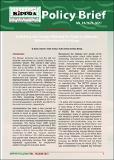| dc.date.accessioned | 2021-10-18T13:17:23Z | |
| dc.date.available | 2021-10-18T13:17:23Z | |
| dc.date.issued | 2021 | |
| dc.identifier.uri | http://repository.kippra.or.ke/handle/123456789/3267 | |
| dc.description.abstract | The Kenyan economy has over the last two decades experienced an upward trajectory in economic growth. The country’s real Gross Domestic Product (GDP) more than doubled from Ksh 2,150 billion in 2001 to Ksh 5,049 billion in 2019. This notwithstanding, the country faces significant labour market challenges in form of unemployment, time-related underemployment and inactivity.1 Unemployment is disproportionately high among marginalized groups such as youth and women. Whereas the overall unemployment of the working age group (15 to 64 years) was estimated at 7.4% as per the most recent Kenya Integrated Household Budget Survey (KIHBS) 2015/16, the prevalence for youth (15 to 24 years) and women were 17.7% and 9.6%, respectively. Further, time related under-employment was estimated at 20.4% for the overall population and 35.9% and 26.0% for the youth and women, respectively | en |
| dc.language.iso | en | en |
| dc.publisher | Kenya Institute for Public Policy Research and Analysis | en |
| dc.relation.ispartofseries | PB/10/2020-2021 | |
| dc.subject | Infrastructure | en |
| dc.subject | Unemployment | en |
| dc.subject | Underemployment | en |
| dc.subject | Youth Empowerment | en |
| dc.subject | Technology and Innovation | en |
| dc.title | Policy Brief No. 10 of 2020-2021 on Exploiting Job Creation Potential for Youth in Industries Without Smokestacks in Kenya | en |
| dc.type | KIPPRA Publications | en |
| ppr.contributor.author | Onsomu, Eldah; Nyabaro, Violet; Munga, Boaz & Shibia, Adan | |

